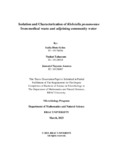| dc.contributor.advisor | Hasanuzzaman, Md. | |
| dc.contributor.advisor | Hque, Fahim Kabir Manjurul | |
| dc.contributor.author | Selim, Sadia Binte | |
| dc.contributor.author | Tabassum, Nuzhat | |
| dc.contributor.author | Ananna, Jannatul Nayeem | |
| dc.date.accessioned | 2023-08-08T06:31:39Z | |
| dc.date.available | 2023-08-08T06:31:39Z | |
| dc.date.copyright | 2023 | |
| dc.date.issued | 2023-03 | |
| dc.identifier.other | ID 19126056 | |
| dc.identifier.other | ID 18126024 | |
| dc.identifier.other | ID 18126067 | |
| dc.identifier.uri | http://hdl.handle.net/10361/19360 | |
| dc.description | This thesis is submitted in partial fulfillment of the requirements for the degree of Bachelor of Science in Microbiology, 2023. | en_US |
| dc.description | Catalogued from PDF version of thesis. | |
| dc.description | Includes bibliographical references (pages 59-61). | |
| dc.description.abstract | This study is designed to conduct an experiment by following a standard protocol established according to the lab facilities and resources which is focused on the highly rising cause of respiratory infection of humans as well as an increasing risk factor at the sector of acquiring multidrug resistance genes and becoming a challenge to treat patients with severe conditions or different types of diseases at the same time. In this study the highly known Carbapenem and beta lactamase producing Klebsiella pneumoniae has been given the priority to experiment the fact that how much resistance and sensitivity is related to this organism in the context of Bangladesh, especially in highly polluted and unhygienic condition of Dhaka city. Therefore, to conduct this experiment three different locations have been selected primarily to observe the pattern of Klebsiella pneumoniae in the hospital wastewater and adjacent communities around those hospitals on a yearly basis which is conducted from June to November for our group. The main objective of this study was to observe and monitor if there is any correlation or connection among the strains of Klebsiella pneumoniae that can cause a threat of resistance towards multiple antibiotics specially the carbapenems (Meropenem, Imipenem etc.) and other antibiotics of different generation. Also, it was operated to gain the idea about how likely the chances are for this organism to gain resistance genes from different regions of hospitals and their nearby communities. This hypothesis of correlation is regarded as an experiment which does not only focus on the resistance pattern but also the fact that, if there is any chance of any kind of outbreak from this type of correlation or so on. Furthermore, this experiment focused on more specific and confirmatory methods for identification and confirmation of target organism Klebsiella pneumoniae which is PCR (Polymerase chain reaction) and ATCC strains are used as positive controls. Since biochemical methods are not that accurate like PCR and also require time and resources, these methods are kept aside to continue the study in a standard procedure. Moreover, antimicrobial susceptibility tests were performed to check the resistance and sensitivity towards different antibiotics which will be described in the methods and result section. The quality of drinking water and the distribution systems as well as waste management of hospital water has now become one of the major concerning issues for spreading antimicrobial resistance among different organisms specially for ubiquitous organisms like Klebsiella pneumoniae. (Giri et al., 2021) Since this is an emerging problem for public health it has become an unavoidable concern to test the presence of antibiotics and organisms that may develop resistance against those available antibiotics. (Armstrong et al., 1981, Schwartz et al., 2003). Although several researches have been conducted relevant to this study in different countries like USA, China, Singapore, this type of correlation study is a new opening in our country. (Armstrong et al., 1981, Xi et al., 2009) Therefore this study was primarily designed to focus on the residence of sensitivity as well as resistance of several antibiotic resistance genes from the source of hospital waste water and nearby community tap water. The results showed the presence of resistance in penicillin such as- ampicillin, cefixime, amoxiclav resistance in a 6 months laboratory observation of Klebsiella pneumoniae. In addition to that the good news for an overpopulated country like ours where awareness of people and control of antibiotic uses are challenging, we did not find any resistance against carbapenem, imipenem or beta lactamase antibiotics. | en_US |
| dc.description.statementofresponsibility | Sadia Binte Selim | |
| dc.description.statementofresponsibility | Nuzhat Tabassum | |
| dc.description.statementofresponsibility | Jannatul Nayeem Ananna | |
| dc.format.extent | 61 pages | |
| dc.language.iso | en | en_US |
| dc.publisher | Brac University | en_US |
| dc.rights | Brac University theses are protected by copyright. They may be viewed from this source for any purpose, but reproduction or distribution in any format is prohibited without written permission. | |
| dc.subject | Klebsiella pneumoniae | en_US |
| dc.subject | Medical waste | en_US |
| dc.subject | Community water | en_US |
| dc.subject.lcsh | Klebsiella pneumoniae | |
| dc.subject.lcsh | Waste disposal--Environmental aspects | |
| dc.title | Isolation and characterization of Klebsiella pneumoniae from medical waste and adjoining community water | en_US |
| dc.type | Thesis | en_US |
| dc.contributor.department | Department of Mathematics and Natural Sciences, Brac University | |
| dc.description.degree | B. Microbiology | |

